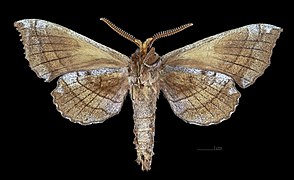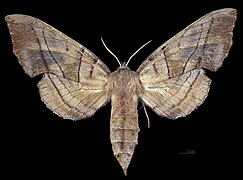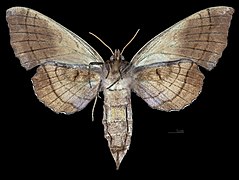Amorpha juglandis
| Amorpha juglandis | ||||||||||||
|---|---|---|---|---|---|---|---|---|---|---|---|---|

Amorpha juglandis |
||||||||||||
| Systematics | ||||||||||||
|
||||||||||||
| Scientific name of the genus | ||||||||||||
| Amorpha | ||||||||||||
| Grote , 1903 | ||||||||||||
| Scientific name of the species | ||||||||||||
| Amorpha juglandis | ||||||||||||
| ( Fabricius , 1777) |
Amorpha juglandis is the only butterfly species of the genus Amorpha from the family of hawkers (Sphingidae). The species is so variable in color that six different populations were named differently. However, today these names are all considered synonyms of the species.
features
Characteristics of the moth
The moths have a fore wing length of 23 to 41 millimeters. They are colored in different shades of brown, with the body having the same basic color as the wings. The outer edge of both pairs of wings is fluted. The forewings carry a pair of post medial lines and a pair of anterior medial lines. In some individuals, the medial region bounded by these lines is significantly darker than the rest of the forewing. The species is also very variable within a population. The coloration can range from very pale to dark red-brown and from monochrome to strongly contrasting light and dark. More often than not, the males are more variable than the females within a population. The latter have thread-like antennae , the former are broadly double-combed.
Characteristics of the caterpillars
The caterpillars have a granular body with a green to green spotted or red to red-brown basic color. They are heavily provided with secondary bristles. They have seven whitish longitudinal stripes on the sides, the last and strongest of which extends to the anal horn . Her face has a pair of elongated stripes that converge on the top of the very pointed head. The anal horn, which is strongly curved backwards, is strongly wrinkled.
Characteristics of the dolls
The pupa is different from those of all other North American hawk species. It is beige to red-brown and almost black in color. Its surface is matt, very rough and has spines on its back. The abdomen is flattened ventrally on the seventh to tenth segment. The cremaster is very short and wider than it is long. It ends in sharp points.
Occurrence
The species is widespread in eastern North America from central Florida to southern Canada . To the west, it spreads to the Great Plains , where it was found in western Nebraska, Oklahoma and Texas ( Big Bend ). The species also occurs along southern Canada in Nova Scotia , New Brunswick , Québec , Ontario and Manitoba .
The species is considered to be a species of the eastern North American mixed forests. In the western part of its distribution, it populates mountains and hill country with forest areas.
Way of life
The adults are strongly attracted by artificial light sources. It is not documented whether they suck nectar. Since both the muscles and the proboscis, which are only two to three millimeters long, are stunted, it can be assumed that they are unable to eat like many other species of the Smerinthinae .
Flight and caterpillar times
In the north, the species flies in summer between mid-May and early July, in one or occasionally a second, incomplete generation. Further south it is unclear in how many generations the species flies. They fly there between April to September, with two to four generations per year being given in the literature.
Food plants of the caterpillars
The caterpillars feed primarily on real walnut ( Juglans regia ), butternut ( Juglans cinerea ) and hickory ( Carya ), all from the walnut family (Juglandaceae). In the north, the caterpillars also seem to feed on other plants such as birch ( Betula ) in northern Wisconsin, hazel ( Corylus ) and alder ( Alnus ) in western Ontario and beech ( Fagus ) in Nova Scotia.
development
The females lay their eggs individually on the underside of the host plants. Pupation takes place in a loose cocoon on or just below the surface of the earth. If the caterpillars are threatened by predators such as birds, they force air out of the rear breathing openings. This produces a whistle of 82 decibels (measured five centimeters away). Experiments by Jayne E. Yack with gold warblers showed that all caterpillars survived and the birds gave up after two attacks, sometimes even reacted in panic
supporting documents
Individual evidence
- ↑ a b c d e f g h i j James P. Tuttle: The Hawkmoths of North America, A Natural History Study of the Sphingidae of the United States and Canada . The Wedge Entomological Research Foundation, Washington, DC 2007, ISBN 978-0-9796633-0-7 .
- ↑ Bild der Wissenschaft 3/2011, p. 12, kick-off shocked birds .
- ↑ The Journal of Experimental Biology, Vol. 214, p. 30
literature
- James P. Tuttle: The Hawkmoths of North America, A Natural History Study of the Sphingidae of the United States and Canada , The Wedge Entomological Research Foundation, Washington, DC 2007, ISBN 978-0-9796633-0-7 .



